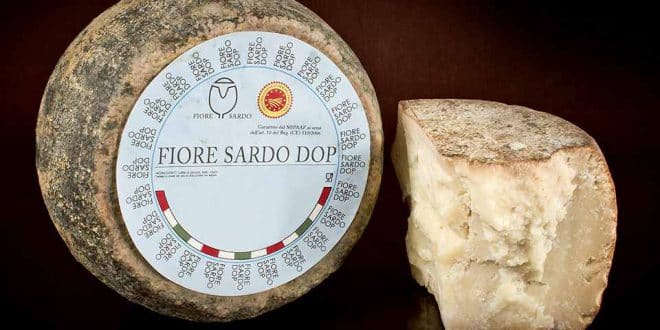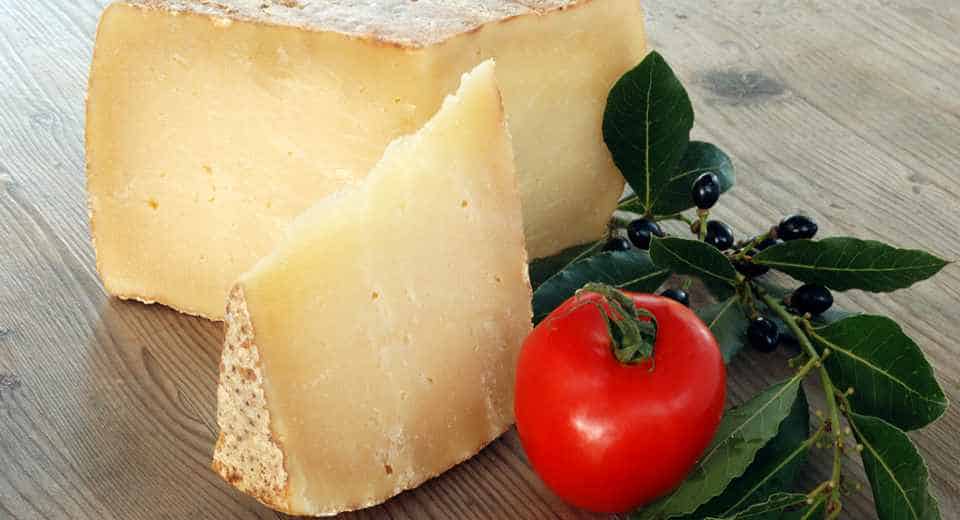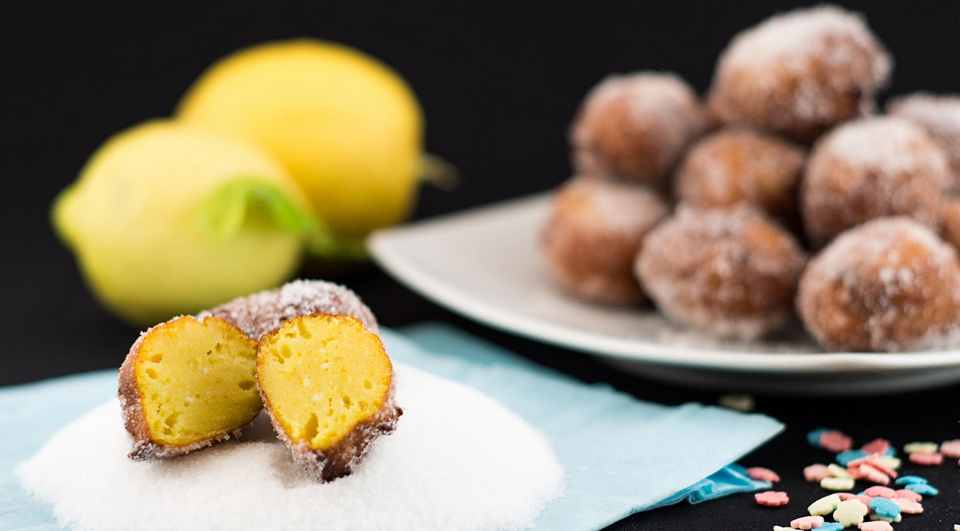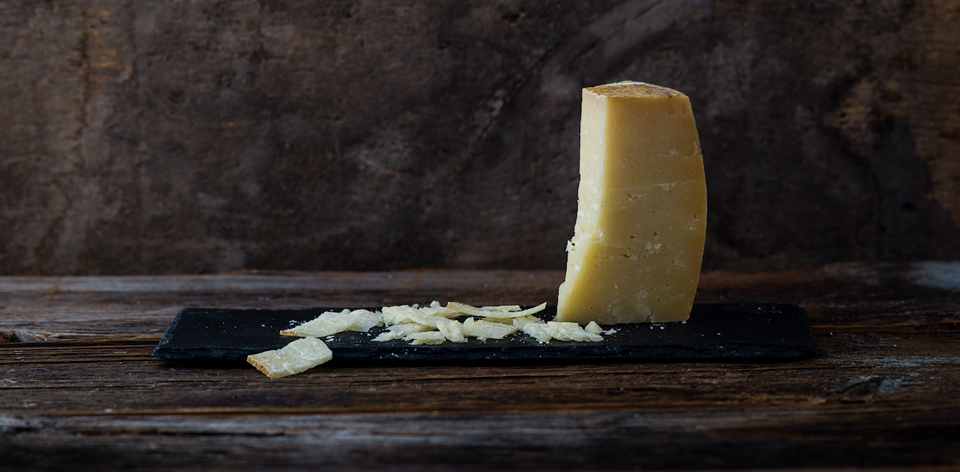Arguably, the most romantic name in the Italian culinary world belongs to the cheese Fiore Sardo, which translates to “Flower of Sardinia.” It has adorned Sardinian tables for centuries. This cheese is exclusively made on the island using only sheep’s milk. Now, let us paint a portrait of this remarkable cheese with words.
Page Contents
History
The historical significance of Fiore Sardo is truly astonishing. It can be said that it was born in Sardinia (Sardegna) when the first settlers arrived on the island. They engaged in sheep farming not only for meat, wool, and leather but also for milk, which was preserved through cheese-making.
The origin of this product dates back to the Bronze Age, a period of history that ended over 1000 years before the birth of Christ.
According to one version, the cheese derived its name from the method of curdling milk using substances from the thistle flower, which were later replaced by rennet.
Further research revealed that initially, the cheese matured in forms made of pear or chestnut wood, with a peony carved at the bottom. Additionally, each farmer could use other flowers to distinguish their product in the market. Some historians lean towards this explanation for the origin of the name “Fiore Sardo.”
Diodorus Siculus, in 59 BC, describing the Roman invasion of Sardinia, noted that cheese was one of the main foodstuffs for the people hiding in the mountains from the conquerors.
After the 6th century, thanks to the mass production of Sardinian dairy products, Fiore Sardo became an item of trade with the inhabitants of Genoa (Genova) and Pisa. In one of the letters, a governor in Sardinia proudly reported that he had “loaded the entire galleon (a sea vessel) with cheese for international trade.”
Different sources indicate that in the 9th century, Fiore Sardo was the only known cheese exported beyond the island. It was especially cherished by merchants from Naples (Napoli) and Livorno. In the 19th century, cheese began to be used in Liguria (Liguria) for the preparation of pesto sauce.
In the mid-20th century, its production became regulated. Then, in 1996, the European Union granted Fiore Sardo the DOP designation, emphasizing its historical, gastronomic significance, and traditional production methods.
Technology
Fiore Sardo cheese is produced throughout the territory of Sardinia. It is made exclusively from the milk of Sardinian sheep, which are raised and grazed on the island. The milk from one or two milkings is curdled at a temperature of 33-35 degrees Celsius using lamb rennet in large copper vats.
After 15 minutes of the process, a curd forms, which is then broken into small granules using a traditional tool. The curds are left to rest for 5 minutes and then placed in steel molds. To facilitate whey drainage, the curds are turned several times and undergo traditional procedures called “piccàu” and “arremundàu,” as practiced in Sardinia.
Before the salting process begins, the cheese heads are scalded (not boiled, unlike pecorino) by briefly immersing them in hot water. This helps to form a firm and smooth rind. The future Fiore Sardo cheese is then immersed in brine for 36-48 hours.
Another distinctive process in the production of Fiore Sardo cheese is the smoking, which takes place for 10-15 days in special rooms. The smoke comes from slowly smoldering branches and leaves of plants unique to Sardinia (myrtle is always used). This gives the cheese a specific aroma and a yellowish color on the rind.
The cheese heads are then transferred to cellars for aging. These spaces are often made of granite, which ensures high humidity, low temperature, and good ventilation. During the aging period, the cheese is rubbed with a mixture of olive oil and wine vinegar. The minimum aging period is 3 months, and matured six-month-old Fiore Sardo cheese is also produced.
Characteristics and culinary uses
Fiore Sardo is a hard sheep cheese. It has a rounded shape resembling a barrel with highly convex sides, with a diameter of 12-20 cm and a height of 12-15 cm. The weight of the cheese heads varies from 1.5 to 4 kg. The rind ranges in color from yellow to dark brown, depending on its age. The surface feels greasy due to the applied mixture during aging. The cheese paste is white to light yellow in color, without any holes.
Fiore Sardo has a distinctive flavor with hints of milk and dried fruits. When young, the cheese has a slight spiciness, while when matured, it is rich in the aromas of the herbs used during smoking.
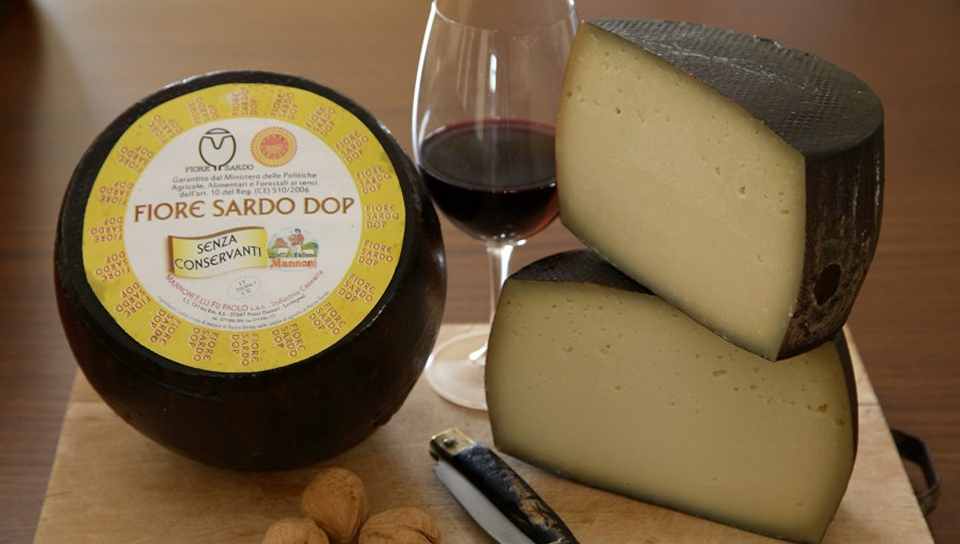
Fiore Sardo is incredibly unique and distinctive, making it suitable for both traditional dishes and creating new recipes. It maintains its aroma and texture even when stored outside the refrigerator for a long time.
Young Fiore Sardo cheese is sliced or cubed and served on its own. It pairs well with legumes and fresh, crusty bread. It is often used as an appetizer with Sardinian red wines such as Cannonau di Sardegna.
Mature Fiore Sardo cheese is grated and used in pasta dishes, porridges, and fried potatoes. It goes well with fresh tomatoes and onions. In Sardinia, it is sprinkled on Frattau bread with tomato sauce, olive oil, and a poached egg. The cheese beautifully complements the aroma of red wines like Malvasia di Bosa DOC and white wines such as Vernaccia di Oristano, balancing their light acidity with a bitter aftertaste, typical of Sardinian floral notes.
A traditional Sardinian dessert is “Sos arrubiolus” – fried cheese-filled balls. And we can’t help but share this wonderful recipe with you.
Sos Arrubiolus – Sardinian Cheese Donuts
To prepare this dessert, you will need:
- 300g Fiore Sardo cheese
- 150g semolina
- 2 eggs
- 200g + 50g powdered sugar
- Zest one lemon and one orange
- A pinch of saffron and salt
- Vegetable oil for frying
Grate the cheese using a coarse grater and add it to 100g of semolina. Mix in the eggs, zest, 200g of powdered sugar, saffron, and salt. Stir everything well until you have a homogeneous dough. Pinch off small pieces of the mixture and roll them into balls. Roll the balls in the remaining semolina and fry them in hot oil until golden brown. Place the cooked donuts on a paper towel to remove excess oil. Serve them dusted with powdered sugar or drizzled with honey. Sos Arrubiolus is an excellent and unique dessert option to accompany tea on a festive table.
Caloric Content and Benefits
The caloric content of fiore sardo is significant, amounting to 411 kcal per 100 grams of the product. Its nutritional value consists of:
- Protein: 28 grams
- Fat: 33 grams
- Carbohydrates: 0 grams
Due to its high fat content, the recommended daily portion of cheese for a healthy individual should not exceed 50 grams. Consumption of fiore sardo by individuals with diabetes, elevated cholesterol, and cardiovascular diseases should be coordinated with a doctor.
As a product made from sheep’s milk, fiore sardo is a source of easily digestible proteins, which are valuable components for building vital compounds.
The cheese provides the body with calcium and phosphorus, which are responsible for the strength of bones, teeth, muscle tone, and nerve impulse conduction. The sodium and potassium content in a portion of fiore sardo is optimal to avoid side effects while ensuring the proper functioning of the nervous and cardiovascular systems.
This rich product is also abundant in vitamins B1, B2, A, and niacin (vitamin B3), which contribute to the healthy functioning of most systems and organs in the human body.
Price in Italy
To buy fiore sardo in Italy, there is no need to visit Sardinia specifically. You can do it while being in any region of the country. This cheese falls into the category of relatively expensive products. Its price ranges from 19 to 26 Euros per 1 kilogram.
And here is the portrait of the marvelous Sardinian flower. We hope that you will have the opportunity to savor its aroma at least once. Love unreservedly, live openly, travel culturally, and remember: “What’s in a name? Fiore smells like fiore, call it pecorino or not!”
Interesting Facts about Fiore Sardo
- Fiore Sardo is an ancient cheese with a rich history. Its origins can be traced back over 2,000 years to the island of Sardinia, Italy.
- This cheese is made exclusively from the milk of Sardinian sheep, known for grazing on wild herbs and grasses, giving Fiore Sardo its unique flavor.
- Fiore Sardo is crafted using traditional, time-honored techniques. It is smoked over burning juniper branches, infusing the cheese with a distinct smoky aroma and flavor.
- The cheese undergoes a minimum aging period of 3 months, but some varieties are aged for up to 18 months or more, resulting in a complex and robust flavor profile.
- Fiore Sardo is characterized by its firm texture, which becomes crumbly and slightly granular with age. Its natural rind is often covered with black mold, adding to its rustic appearance.
- The cheese has a rich, intense, and slightly sharp flavor with hints of caramel, nuts, and herbs. It pairs exceptionally well with robust red wines, fruits, and crusty bread.
- Fiore Sardo has received recognition and protection as a PDO (Protected Designation of Origin) cheese, ensuring its authenticity and adherence to traditional production methods.
- Due to its smoky flavor, Fiore Sardo is a fantastic cheese for adding depth to various dishes. It can be grated over pasta, melted into gratins, or enjoyed on a charcuterie board.
- As an artisanal cheese, Fiore Sardo is crafted in limited quantities by skilled cheesemakers, making it a sought-after delicacy for cheese enthusiasts and connoisseurs.
- The name “Fiore Sardo” translates to “Sardinian flower,” evoking the beauty and uniqueness of this cheese, which is deeply rooted in Sardinian culture and culinary traditions.
 Italy for me From Italy with love
Italy for me From Italy with love

